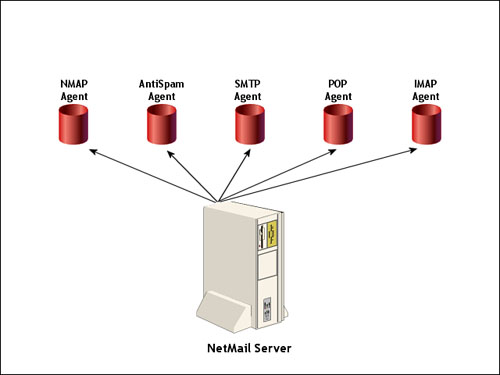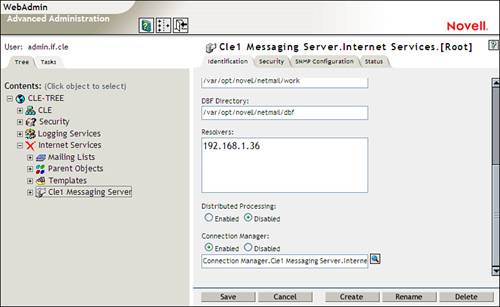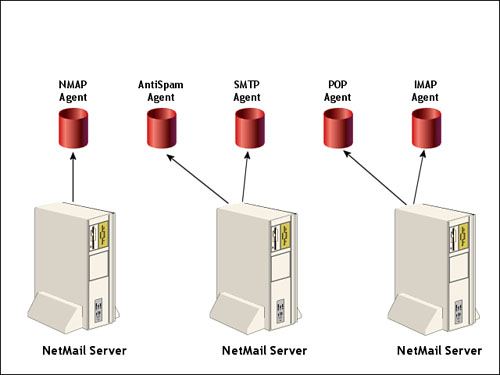Designing, Installing, and Configuring NetMail
| < Day Day Up > |
| Test Objectives Covered:
The modular nature of NetMail provides you with a great deal of flexibility in how it is deployed. The first topic we need to cover here is how to plan your NetMail deployment. Planning Your NetMail DeploymentThe way you deploy NetMail is heavily dependent on the load you anticipate it to handle. If your NetMail system will be servicing tens of thousands of users, you may want to consider a distributed system. According to Novell, a single Linux server running NetMail can handle up to 30,000 users and 1.1 million messages a day. This probably works great in the lab, but in a production environment, you should probably scale that number back to around 10,000 users. Both of these numbers assume that you aren't running much else on the server, such as iFolder or iPrint. If you're running multiple services on the single server along with NetMail, you should reduce the maximum number of supported users even further. Even at that, it should be noted that a single NetMail server supports a tremendous number of users when compared to other competing enterprise email solutions. This serves as a strong testament to the scalability of both the Linux operating system and Novell's NetMail service. Let's look at how a single-server system is implemented. Single-Server DeploymentIn a single-server deployment, all the NetMail components are installed on the same server, as shown in Figure 10.25. Figure 10.25. Standalone NetMail deployment. The advantages of this strategy are ease of implementation and ease of administration. All your components and agents are on the same server. For a small-to-medium organization, this is a viable deployment option. To deploy your NetMail server in this fashion, you need to ensure that the Distributed Processing attribute of the Messaging Server object is disabled, as shown in Figure 10.26. Figure 10.26. Configuring a standalone NetMail server. However, if you've worked with servers for any length of time, you can probably see a couple glaring downsides to this type of deployment. Key among them is fault tolerance . If something were to happen to your Linux server, such as a failed hard drive, an overheated CPU, or even an extended power outage , your organization's mail service will go down. Nothing will make you more unpopular with the users you support than for them not to be able to access their email accounts. This type of deployment also has limited scalability. If your organization grows and your server is required to support more user mailboxes, its performance is going to slip accordingly . If your NetMail implementation is intended to support a large organization, you should consider a distributed deployment. Distributed DeploymentIn a distributed deployment, you install different NetMail components on several different Linux servers in your eDirectory tree. Although they are distributed, all the components function together as a unified NetMail service. This type of deployment is shown in Figure 10.27. Figure 10.27. Distributed NetMail deployment. To deploy your NetMail servers in this mode, you need to ensure that the Distributed Processing attribute of the Messaging Server object is enabled. You also need to make sure that each server that will host a NetMail component has been installed into your eDirectory tree. When you install NetMail, each server will have an associated Messaging Server object within the Internet Services container in your eDirectory tree. Because all the servers exist in the same tree, they can interact with each other to share NetMail components. The benefits of this strategy are clear. By distributing components among several servers, you dramatically increase the scalability and speed of NetMail. You can also use this configuration to increase the level of fault tolerance of the system if you place NetMail components redundantly on different servers. The main drawback to this strategy is the increased level of complexity. It requires considerably more hardware and expertise to deploy. For the CLE exam, you only need to know how to deploy a single-server system. With your deployment plan in place, the next thing we need to talk about is actually installing the NetMail service. Installing NetMailBefore you install your NetMail servers, you need to keep a few points in mind:
After accounting for these items, you're ready to install NetMail. If you performed an Express NNLS installation, NetMail was installed on your system. If you performed a Custom install, you had the opportunity to select the NetMail component for installation. If you didn't select NetMail during the initial installation of NNLS, you can perform a post-installation by completing the following steps:
With NetMail installed, you're ready to configure your system. Configuring NetMailThe default installation of NetMail is extremely simple and affords you a working email system with little-to-no administrative intervention. However, because of its modular nature, NetMail can be a complex product to configure. As I pointed out earlier, each component has its own set of properties that you can configure. There are potentially thousands of different ways you could configure your NetMail system. Rather than bore you with a review of each component's configuration parameters, a better approach to learning how to configure NetMail is to work with your system in a hands-on lab exercise. |
| < Day Day Up > |
EAN: 2147483647
Pages: 128


